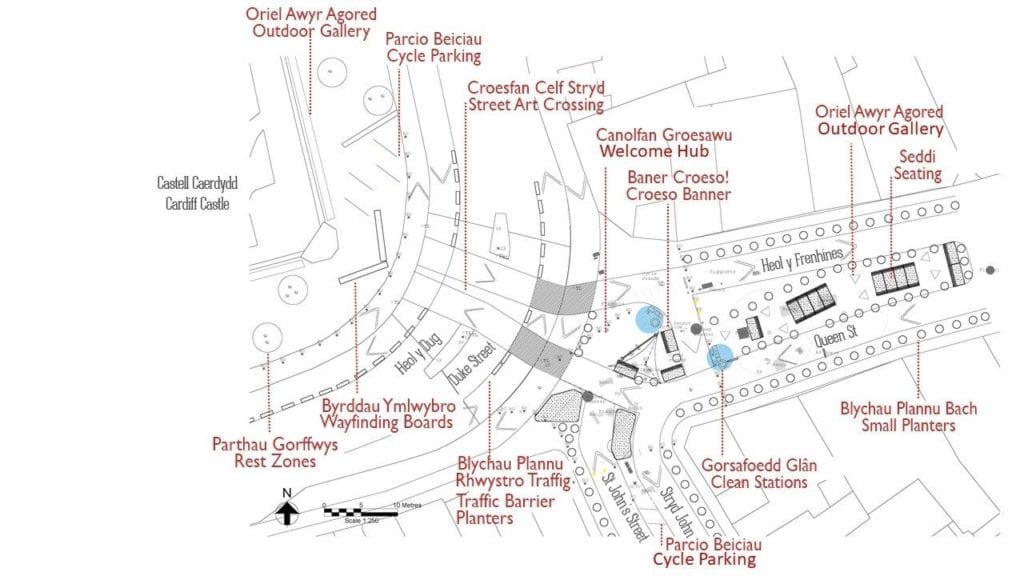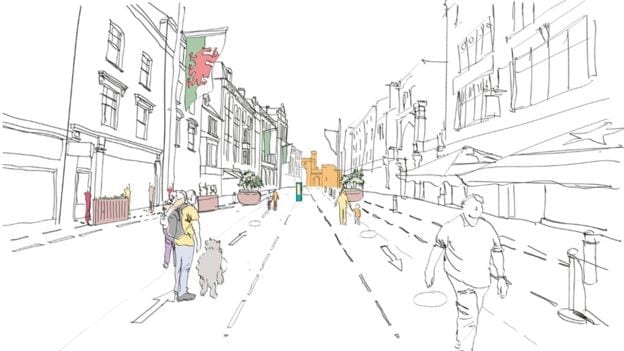Creating one-way walking systems to safeguard the public, setting up welcome points to explain how moving round the city centre will work and opening up Cardiff Castle’s grounds to create a ‘new’ public square for local businesses to use are just some of the schemes Cardiff Council is considering as it prepares to exit lockdown.
A detailed plan of action has been published by the council which outlines a raft of innovative measures with the aim of making Cardiff one of the ‘safest’ cities in the UK as life begins its return to ‘normal’.

The plan has been developed with Arup, recognised technical experts on redesigning cities. It will be used to consult residents, businesses and councillors on how the council will:
- safely re-open the Welsh capital making it accessible to all;
- support businesses as they start to trade again;
- re-establish footfall in the city centre while complying with social distancing requirements;
- help people to access the city centre despite reduced public transport capacity; and
- promote Cardiff so that it develops a reputation as a safe, welcoming, exciting and forward-thinking place to visit post-lockdown.
Leader of Cardiff Council, Cllr Huw Thomas, said: “These plans start to outline how life can resume and how Cardiff can prosper despite COVID-19. We want to restart, recover and renew Wales’ capital and I’m determined that when lockdown restrictions are lifted, our city will reopen in a way that is safe for everyone; in a way that does everything it can to safeguard thousands of jobs; and in a way which is both welcoming and confident about the future of Cardiff.
“We are working through the finer details of these plans with businesses, residents, and local Councillors and I’m confident if we adopt the same ‘one-city’ approach that has seen the public sector, communities and businesses pull together throughout the pandemic, then we can truly make a reality of the common desire to ‘build back better’.
“I’m especially excited about our proposals to open up Cardiff Castle’s grounds as a new ‘public’ square for local residents to use for free. The castle grounds are spectacular. It could provide restaurants and cafes with covered areas to use, giving them a chance to make up for floor space and clients they would otherwise lose because of having to observe social distancing rules in their properties.
“We are also working with a local technology firm to develop an App which could see people order their food from the castle and then have it delivered to enjoy in the finest setting the city has to offer. I’m also keen that we work with the music board to bring live music back to the city as soon as we can. We will look at ways of using public space to create safe event spaces where people can enjoy music and street entertainment in a safe and welcoming environment.”
The plan outlines a series of measures designed to open the city safely and in a way that will encourage people to return to work, to shop, do business and enjoy the wide range of restaurants, cafes and bars the city is home to.
The measures include:
Welcome Points– installed at the main pedestrian access points to the city. Welcome Points will offer information to the visitor/shopper/worker on how the city centre works, how to visit in a safe way, how to reach particular destinations, a walking plan, hand-washing facilities, cycle-parking facilities and a member of staff to assist.Signage and street ambassadorswill also be available throughout the city centre to assist visitors and re-enforce the information provided at the welcome point.

One-way pedestrian movement– Pedestrians (shopper/workers/visitors) within the city centre will need to follow signed/marked routes to ensure social distancing is observed. There will be a series of one-way movements with earmarked spots to reverse the direction of travel (a leap-frog point). Pinch points have also been identified where pedestrian movement will need to be restricted to one-way travel, or single file movement to ensure an adequate social distance can be achieved. A series of routes around the city centre is being developed taking account of the retail offer, transport hubs (bus stops, taxi ranks, stations & car parks). A plan is being developed to cover all city centre streets, dependent upon footfall and the availability of safe (socially distanced) walking space.
Queues– As each retail unit /shopping centre/arcade will only be able to operate in a safe manner by restricting the number of users at any one time, there will be an inevitable impact on the streets outside the shops. Designated queuing areas will be identified and marked on-street. There will need to be some (hot/cold/wet) weather protection for people queuing outside any of the attractions.
Public Realm and Spill-Out Areas – The council recognises that several businesses in the hospitality sector (restaurants/cafes/bars) could be seriously affected by the need to follow social distancing rules. With that in mind the Council is proposing to open up spill-out areas and give space in the public realm over to businesses to use for free. It is essential that the key streets, public spaces and new spill-out spaces allow social distancing, are safe, well connected, and present an attractive green environment appropriate in a capital city environment. The plan identifies a number of ‘spill-out spaces’ where there can be more managed social activity and safeevents. These include the grounds inside and around the main walls of Cardiff Castle, the northern end of Churchill Way, the Hayes and Mill Lane.
Car Parking – many of the existing city centre car parks will need to operate at a reducedcapacity in order to enable people to leave and return to their cars in a safe manner. A combined (public/private) approach to the availability of city centrecar parking is being developed. To support this a comprehensive network of Park and Ride/Park and Stride/Park and Cyclefacilitiesneed to be developed to manage car access away from the centre, but to allow easy walking/cycling/bus access for the ‘last mile’ of the journey.
Accessing the City Centre – An integrated city transport plan will help people access the city centre via car, public transport and active travel (walking or cycling).The transport plan could see the city centre put into ‘event mode’. This would see road closures similar to those put in place for major rugby internationals in the Principality Stadium.
An ‘event mode’ closure would allow our limited, city-centre spaces to be used most efficiently, enabling safe, social-distanced public movement, access to businesses and new spill-out spaces.A managed cordon would be set up around the city centre allowing caraccess, and bus/active travel movement.
Security and Aggressive Begging – all on-street security issues are being discussed/agreed with the police who have offered support to manage pedestrians and any social-distancing issues.A long-term strategy to help the homeless after lockdown is lifted is being developed. 140 people experiencing homelessness have been housed in newly acquired accommodation since the outbreak began. Of this number 30 had been rough sleeping and the intention is to make sure those people do not return to the streets. The lack of begging opportunities in the city centre has meant clients, who have been left unable to fund harmful addictions, have responded more positively to support services and have begun treatment programmes. Cardiff’s Homeless partnership has been working throughout the pandemic to take this opportunity to help people begin tackling their addictions. The number of people sleeping rough in the city has dropped to single figures since lockdown. Outreach continues to work with the individuals on the street to try to encourage them to take up offers of accommodation and help. Unfortunately, money raised from begging can be enough to allow people to fund their addictions and refuse offers of help.
Local Neighbourhood Centres
It’s also important to introduce measures to ensure neighbourhood centres can re-open for businesses, while ensuring safe access for the public. In many cases pavements are not wide enough to enable social distancing and queuing outside shops onto pavements could become a cause for concern. We will introduce a range of schemes as soon as it’s practical, including a package of safety and greening measures including pavement widening, cycle routes and 20mph speed limits. Measures which will be piloted at Wellfield Rd in the Roath area could also be rolled out to other neighbourhoods.
Car Access
As lockdown restrictions ease and people return to work, it’s important the transport system is managed in a way that enables social distancing and keeps people safe. Capacity on public transport is likely to be limited for several months and there would be negative impacts in terms of air quality, congestion and emissions if everyone chose to drive instead. Around 29% of households in Cardiff do not have access to a car or van meaning it is essential to provide safe and sustainable alternatives to public transport. This will largely be in the form of improved walking and cycling infrastructure, and residents who can will be encouraged to consider active travel methods for shorter journeys.
Cllr Caro Wild, Cabinet Member for Strategic Planning and Transport said:
“It is essential that we do what we can to enable people to continue to cycle and walk as lockdown restrictions ease. There is a chance for us all now to see first-hand how a greener and a safer Cardiff could look. Capacity on public transport will be limited for some time, and we think a lot of people will continue to work from home, which should reduce car numbers into the city. What we don’t want to see is congestion and pollution levels building again. Especially with the measures we will have to introduce widening pavements to ensure social distancing rules can be followed.
“To help we are looking at delivering a ‘pop-up’ cycleway network to encourage people who can, to cycle into the city centre or their neighbourhood centres rather than drive. We will also look at providing additional cycle parking in key locations in the city centre and in our neighbourhood centres. We will review the potential for creating ‘park and pedal’ sites and we will install bus priority measures such as bus gates to maximise the capacity of buses by minimising journey times and ensuring reliability of services.”
Cllr Russell Goodway, Cabinet member for Investment and Development, said:
“The main economic fallout from the virus will be felt in Cardiff city centre, which accounts for around a third of the city’s jobs. The city centre hosts a large number of the businesses that are already, and will continue to be, the most impacted by the pandemic, due to their reliance on consumer footfall. Potentially 45,000 jobs in the city are at risk: it is anticipated that only a 20% reduction in the economy would see up to 10,000 jobs lost across these sectors. It is therefore crucially important to get as many businesses back operating safely as quickly as possible. Cities across the UK will be competing for footfall. Cardiff needs to win back the confidence of local people, visitors, students and investors.
“It’s clear that urgent action is required to re-open the city centre as a welcoming destination. Our discussions with local employers and business operators have been very positive overall. Everyone knows the city and the economy needs to get moving as soon as it is safe to do so. We want to openup public space for free, and implement flexible licensing arrangements to support businesses which could see their customer numbers hugely reduced by social distancing requirements. If we can open up covered public spaces for some businesses it can give them a chance to get up and running again and it can give them a chance to save jobs.”
The strategic plan and an accompanying Council report will go to Cardiff Council’s Cabinet for discussion on Thursday, June 11. The full document is available to read here
